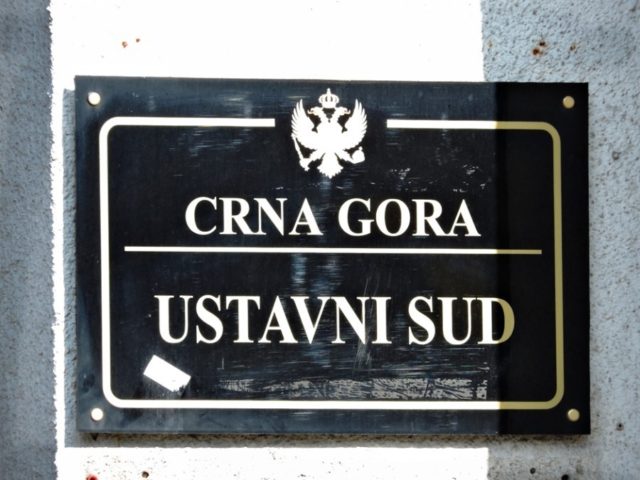
PROTEST AGAINST THE DENIAL OF WAR CRIMES COMMITTED IN LORA
18/12/2024
EVALUATING THE PROSECUTORIAL COUNCIL’S PERFORMANCE IN 2023 AND 2024: ACHIEVEMENTS AND RECOMMENDATIONS FOR IMPROVEMENT
27/12/2024RESOLVING THE TERMINATION OF CONSTITUTIONAL COURT JUDGES’ FUNCTIONS: A CALL FOR URGENT AND LASTING SOLUTIONS

The Constitutional Court of Montenegro is currently functioning outside the parameters set by the Constitution and applicable law, as it includes judges who no longer have the right to perform their duties. Alarmingly, these former judges continue to participate in Constitutional Court sessions intended to inform the proposers—namely, the Parliament and the President of Montenegro—of their mandate terminations. This situation allows them to rule on their own rights and effectively obstruct the appointment of new judges.
If this legal crisis persists, all judges of the Constitutional Court may be regarded as lifetime appointees, thereby fully compromising the integrity of the Court.
The recent decision by the Parliament of Montenegro to dismiss Judge Dragana Đuranović, who is no longer entitled to serve in her judicial capacity, failed to comply with the procedures outlined in the Constitution and the Law on the Constitutional Court. This was primarily due to a June ruling by the Constitutional Court, which declared that Parliament would not be informed of Judge Đuranović meeting the conditions for retirement. However, this ruling constitutes a clear violation of the Constitution of Montenegro and was rendered without legitimacy, as Judge Đuranović participated in the decision-making process despite being required to recuse herself.
The fundamental legal principle Nemo iudex in causa sua (no one can be a judge in their own case) must apply to the Constitutional Court of Montenegro. This principle should be upheld in the upcoming session, where decisions regarding the termination of other two Constitutional Court judges—who are directly affected by the same issue—will be made. Accordingly, those judges must recuse themselves from the decision-making process.
For years, Human Rights Action (HRA) has emphasized that the termination of Constitutional Court judges in Montenegro must conform to the Constitution, following the same rules that apply to all other judges in the country. Article 154, paragraph 3 of the Constitution explicitly states that a Constitutional Court judge’s role concludes when they “meet the conditions for retirement.” Article 121, paragraph 2 establishes the same requirement for other judges. The conditions for retirement are defined solely by the Law on Pension and Disability Insurance, specifying a retirement age of 65 or 40 years of service. The Constitution does not imply that the public function of Constitutional Court judges ends “when their employment is terminated by the force of law” at age 66, as some judges claim. This misinterpretation, not supported by the constitutional text, appears to be driven by self-interest aimed at extending their public office tenures. Such reasoning undermines the constitutional and legal protections that underlie the legal order.
Judges Budimir Šćepanović and Desanka Lopičić reached the age of 65 and/or completed 40 years of service in May and June of this year, respectively. According to both the Constitution and the Law on Pension and Disability Insurance, their judicial functions should have ceased at that point.
For the termination of Constitutional Court judges’ functions to be formally recognized, the Court must adopt a decision and notify the Parliament, the body authorized to acknowledge such terminations. Decisions are made by majority vote among the judges (Article 151, paragraph 1 of the Constitution), necessitating at least four affirmative votes.
This raises a critical question: what happens if a majority of four votes cannot be achieved? This situation can occur due to an insufficient number of judges or disagreements among them, preventing a decision from being made. Such a scenario transpired regarding the termination of Judge Dragoljub Drašković’s function, as reported by Vijesti. At that time, with five judges present, three supported the interpretation that the function should cease under Labor Law (Drašković, Lopičić, Šćepanović), while two argued for termination under the Law on Pension and Disability Insurance (Gogić, Iličković).
In that instance, Budimir Šćepanović, then-president of the Court, informed the Parliamentary Constitutional Committee that no decision had been reached, providing details on the judges’ birth years and years of service. Consequently, the Committee proceeded to establish the termination of Drašković’s function, as reported by Vijesti. At that time, the Constitutional Court had five judges, three of whom supported the interpretation that the function should cease under the Labor Law (Drašković, Lopičić, Šćepanović), while the other two argued it should cease under the Law on Pension and Disability Insurance (Gogić, Iličković).
In this instance, Budimir Šćepanović, then-president of the Court, informed the Parliamentary Constitutional Committee that no decision had been reached regarding Judge Dragoljub Drašković. He provided information on the judges’ birth years and years of service, prompting the Committee to establish the termination of Drašković’s judicial function without incident, political controversy, or opposition from any political party.
In June of this year, during a vote on whether Parliament should be notified of Judge Dragana Đuranović meeting the conditions for retirement—a mandatory prerequisite for terminating her function—the outcome was 4:2. The Constitutional Court, purportedly adhering to protocol, decided not to notify Parliament to announce a vacancy for a new judge to replace Đuranović. Alarmingly, Judge Đuranović herself participated in this decision, allowing her to effectively “decide in her own case” regarding her continuation in office. This privilege—being able to adjudicate one’s legal circumstance—is unique to her and is not extended to any other judge or individual in Montenegro. The principle *Nemo iudex in causa sua* (no one can be a judge in their own case) is enshrined in Article 43 of the Law on the Constitutional Court and should be universally upheld, without exception.
The failure to apply this principle to Đuranović in June, as well as to Judge Drašković in his own case, undermines the integrity of the Constitutional Court. Unfortunately, this is not the only incident that tarnishes its reputation.
Consider Judge Desanka Lopičić, who, on January 27, 2020, was appointed by a majority of four votes (including her own) and held the unconstitutional, fabricated position of “acting president” of the Constitutional Court for ten months. This appointment occurred solely because she could not lawfully serve a second term as the Court’s president. It was evident that securing a judge aligned with the interests of the ruling party (DPS) was crucial in an election year. When this situation was eventually declared unconstitutional under pressure from the European Commission, several NGOs, including ours, demanded accountability and lustration of judges who facilitated this unconstitutional state, including Desanka Lopičić and Budimir Šćepanović.
In conclusion, Human Rights Action (HRA) firmly asserts that the Constitutional Court erred in allowing Judge Đuranović to vote on her own case in June, a decision that directly impacted the continuation of her judicial function. The principle *Nemo iudex in causa sua* is a cornerstone of legal integrity and must be upheld in Montenegro. Had this principle been respected, and Judge Đuranović recused herself from the decision regarding her function’s termination in December, the vote would have resulted in a 3:2 split, preventing any resolution. In such a scenario, Parliament should have been informed and allowed to determine the termination of her function as in previous cases. Without this procedural safeguard, Constitutional Court judges could theoretically remain in office indefinitely, potentially for life.
However, since Judge Đuranović was not excluded from the process, the Constitutional Court formally adopted a decision by the required majority not to notify Parliament. Consequently, Parliament’s subsequent decision to terminate Judge Đuranović’s function was made without a formal ruling from the Constitutional Court, contradicting both the majority position of the Court in June and the stipulations of the Constitution (Article 154, paragraph 3) and the Law on the Constitutional Court (Article 7).
It is critical to note that the Court’s majority stance in June was influenced by the votes of three judges whose own functions were also in question. While the decision pertained only to Đuranović, both Lopičić and Šćepanović—judges whose mandates should have been terminated by that time—also participated in the vote. This circumstance undermines the integrity of the process and emphasizes the urgent need to address systemic issues within Montenegro’s Constitutional Court.
This error must not be repeated. The Constitutional Court should refrain from allowing judges, whose functions are under consideration, to vote on their own cases. If a necessary majority for a decision cannot be attained, it falls to Parliament or the President of Montenegro to determine whether to initiate the process for appointing new judges.
HRA calls for the session of the Constitutional Court on December 25, where the issue of judges’ function termination will be addressed, to be open to the public, in accordance with Article 7, paragraph 2, and Article 29 of the Rules of Procedure.
Furthermore, HRA highlights that the Constitutional Court can organize a special public hearing (as per Article 45 of the Law on the Constitutional Court) to discuss when a Constitutional Court judge’s function should conclude, in the presence of distinguished legal experts and professors of labor and constitutional law. This topic has consistently generated divided opinions among the judges of the Constitutional Court. (HRA has already provided the opinions of Professors Zoran Ivošević and Vesna Rakić-Vodinelić on this matter.)
HRA believes that during the upcoming constitutional amendments, which aim to exclude the Minister of Justice from the Judicial Council, consideration should be given to establishing a legal framework that governs the termination of functions for Constitutional Court judges, regular judges, and prosecutors. This framework must ensure legal certainty and uphold the principle of judicial stability, so that it does not become subject to frequent legislative changes, as has been the case until now.







 English
English